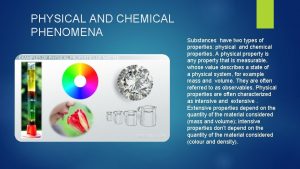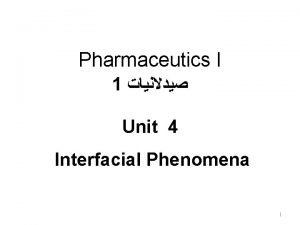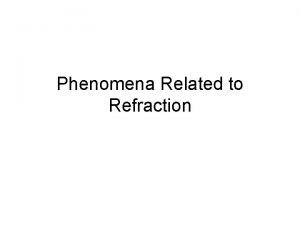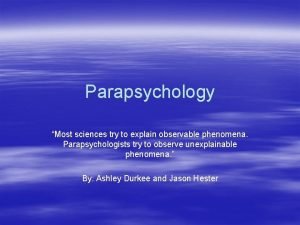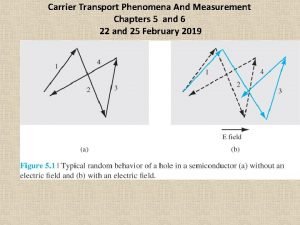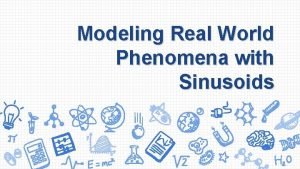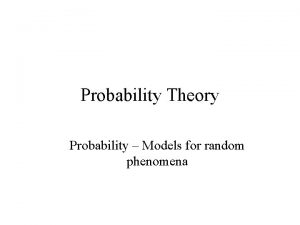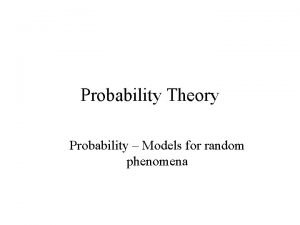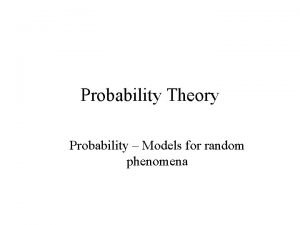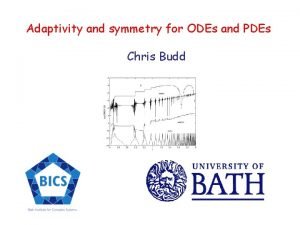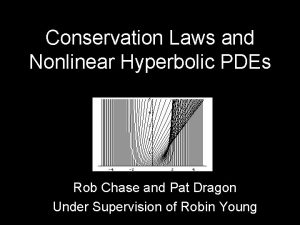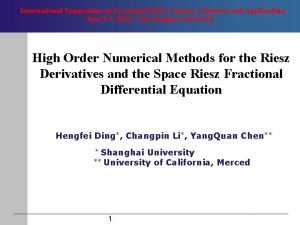PDEs and Examples of Phenomena Modeled n n

























- Slides: 25

PDEs and Examples of Phenomena Modeled n n Ordinary differential equation: equation containing derivatives of a function of one variable Partial differential equation: equation containing derivatives of a function of two or more variables Models: n Air flow over an aircraft wing n Blood circulation in human body n Water circulation in an ocean n Bridge deformations as its carries traffic n Evolution of a thunderstorm n Oscillations of a skyscraper hit by earthquake n Strength of a toy n Financial Markets

Model of Sea Surface Temperature in Atlantic Ocean Courtesy MICOM group at the Rosenstiel School of Marine and Atmospheric Science, University of Miami

Solving PDEs Finite element method n Finite difference method (our focus) u Converts PDE into matrix equation t Linear system over discrete basis elements u Result is usually a sparse matrix u Matrix-based algorithms represent matrices explicitly u Matrix-free algorithms represent matrix values implicitly (our focus) n

FINITE DIFFERENCE In numerical analysis, two different approaches are commonly used: The finite difference and the finite element methods. In heat transfer problems, the finite difference method is used more often and will be discussed here. The finite difference method involves: Ø Establish nodal networks Ø Derive finite difference approximations for the governing equation at both interior and exterior nodal points Ø Develop a system of simultaneous algebraic nodal equations Ø Solve the system of equations using numerical schemes

Finite Difference Methods: Outline Solving ordinary and partial differential equations n Finite difference methods (FDM) vs Finite Element Methods (FEM) n Vibrating string problem n Steady state heat distribution problem n

Class of Linear Second-order PDEs n Linear second-order PDEs are of the form where A - H are functions of x and y only n Elliptic PDEs: B 2 - AC < 0 (steady state heat equations) n Parabolic PDEs: B 2 - AC = 0 (heat transfer equations) n Hyperbolic PDEs: B 2 - AC > 0 (wave equations)

Difference Quotients

Formulas for 1 st, 2 d Derivatives

Vibrating String Problem Vibrating string modeled by a hyperbolic PDE

The Nodal Networks

Finite Difference Approximation

Finite Difference Approximation cont.

Finite Difference Approximation cont.

A System of Algebraic Equations

Matrix Form

Numerical Solutions

Iteration

Example

Example (cont. )

Example (cont. )

Summary of nodal finite-difference relations for various configurations: Case 1 Interior Node

Case 2 Node at an internal corner with convection

Case 3 Node at a plane surface with convection

Case 4 Node at an external corner with convection

Case 5 Node at a plane surface with uniform heat flux
 Pdes inc
Pdes inc The area of a rectangular fountain is (x^2+12x+20)
The area of a rectangular fountain is (x^2+12x+20) Which sum or difference is modeled by the algebra tiles
Which sum or difference is modeled by the algebra tiles Elizabethan tragedies were modeled on plays from
Elizabethan tragedies were modeled on plays from Lesson 1-1 points lines and planes answers
Lesson 1-1 points lines and planes answers Intercept form of a quadratic function
Intercept form of a quadratic function Hughes modeled his stanza forms on
Hughes modeled his stanza forms on Physical and chemical phenomena
Physical and chemical phenomena Colloids examples
Colloids examples Importance of interfacial phenomena in pharmacy
Importance of interfacial phenomena in pharmacy Noumenon
Noumenon Moose monikko
Moose monikko Some natural phenomena
Some natural phenomena Phenomena related to refraction
Phenomena related to refraction Observable phenomenon
Observable phenomenon Objective consideration of contemporary phenomena
Objective consideration of contemporary phenomena Natural language processing
Natural language processing Reference phenomena in nlp
Reference phenomena in nlp Gravitational phenomena
Gravitational phenomena Carrier transport phenomena
Carrier transport phenomena Anchor phenomenon
Anchor phenomenon Observable phenomena meaning
Observable phenomena meaning Reoulox phenomena
Reoulox phenomena Global climate phenomena
Global climate phenomena Random phenomena
Random phenomena Real life sinusoidal examples
Real life sinusoidal examples







